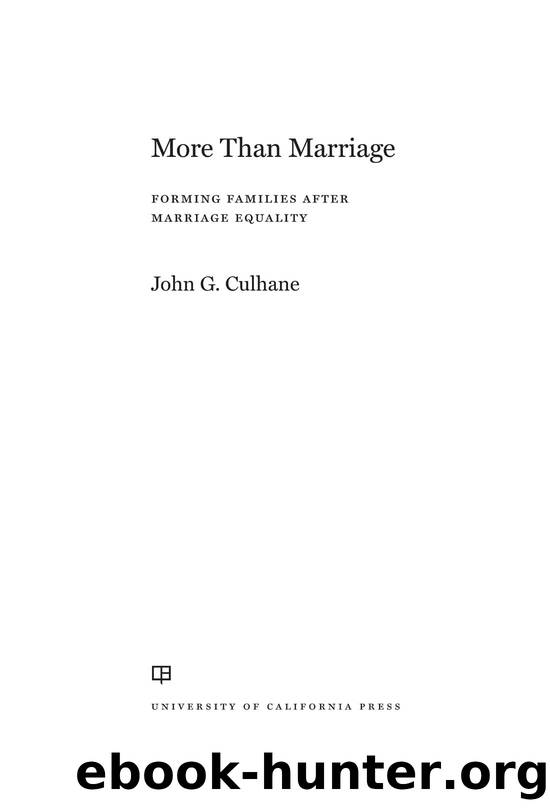More Than Marriage by John G. Culhane

Author:John G. Culhane
Language: eng
Format: epub
ISBN: 9780520391659
Publisher: University of California Press
RECOGNIZING DE FACTO RELATIONSHIPS
Cohabitation has become firmly entrenched over the past several decades. As of 2016, eighteen million Americans were cohabitating without marriage.41 Setting aside for the moment the lively debate about the social costs of this phenomenon, one thing is clear: any system that does not account for this large a population is obviously deficient. To the objection that such recognition would boost an unwelcome competitor to the âpreferredâ institution of marriage, it perhaps suffices to note that broad economic forces are at work that make wedlock unrealistic for many people. As June Carbone and Naomi Cahn have persuasively shown, a dearth of economically and educationally âeligibleâ partners for women partly explains the decline of marriage.42
But deciding what legal rules should be applied to these couples is complex, because when it comes to cohabitation, one size pointedly does not fit all. People cohabitate for all sorts of reasons, at every age, and with or without the intent of eventually marrying.43 Some are not even in intimate relationships yet are interdependent. Some have children together, while some do not. Of course, people marry for all sorts of reasons too, but on average there is greater economic sharing in marriageâin part because of the way the law protects the partiesâ expectations (and thus shapes their behaviors), but not only because of that.44 But if married couples want to avoid the default rules, they can enter into prenuptial agreements that vary their financial relationship (usually by treating them as separate property owners at the marriageâs dissolution).45 Such contracts further collapse the boundary between marriage and cohabitation.
Despite the daunting obstacles confronting any attempt to determine when cohabitation should be treated like marriage, two notable authorities have tried to align the expectations of parties in such relationships more precisely with reality. The Principles of the Law of Family Dissolution, a publication of the American Law Institute (ALI), assimilates the consequences of the dissolution of certain cohabitation relationships to those of divorce but has not been adopted by any US state.46 In Australia, a similar approach has been in effect throughout the country since 2009.47 Cases reflect the effort that Australian judges have been willing to expend in making the difficult decision of whether the members of all kinds of relationships meet the definition of âde facto couple.â If so, when they break up, either person can petition the court for a determination that their assets should be divided and support payments made as though they had been legally married.48
A brief discussion of these two approaches to cohabitation will do two things: show how the law can protect the reality of couplesâ lives even when they have chosen no formal legal status, and foreground the benefits of recognizing relationship statuses other than marriage.
The official commentary accompanying the ALIâs suggested rules on cohabitation begins by noting both the explosion in the number of cohabitating couples and how courts have been searching for creative ways to recognize and safeguard the expectations of the people in these relationships.49
Download
This site does not store any files on its server. We only index and link to content provided by other sites. Please contact the content providers to delete copyright contents if any and email us, we'll remove relevant links or contents immediately.
| Africa | Americas |
| Arctic & Antarctica | Asia |
| Australia & Oceania | Europe |
| Middle East | Russia |
| United States | World |
| Ancient Civilizations | Military |
| Historical Study & Educational Resources |
Cat's cradle by Kurt Vonnegut(14760)
Pimp by Iceberg Slim(13779)
Underground: A Human History of the Worlds Beneath Our Feet by Will Hunt(11839)
4 3 2 1: A Novel by Paul Auster(11792)
The Radium Girls by Kate Moore(11621)
Wiseguy by Nicholas Pileggi(5319)
American History Stories, Volume III (Yesterday's Classics) by Pratt Mara L(5136)
Perfect Rhythm by Jae(5072)
The Fire Next Time by James Baldwin(5017)
Paper Towns by Green John(4800)
Pale Blue Dot by Carl Sagan(4618)
A Higher Loyalty: Truth, Lies, and Leadership by James Comey(4552)
The Mayflower and the Pilgrims' New World by Nathaniel Philbrick(4281)
The Doomsday Machine by Daniel Ellsberg(4246)
Killers of the Flower Moon: The Osage Murders and the Birth of the FBI by David Grann(4189)
Too Much and Not the Mood by Durga Chew-Bose(4095)
The Sympathizer by Viet Thanh Nguyen(4095)
The Borden Murders by Sarah Miller(4019)
Sticky Fingers by Joe Hagan(3912)
